Physical Address
304 North Cardinal St.
Dorchester Center, MA 02124
Obesity is now a global health problem, placing an enormous health burden on our society because of the medical comorbidities that are associated with it, including type II diabetes, hypertension, dyslipidaemia, steatohepatitis, obstructive sleep apnoea, arthritis of the weight-bearing joints, gastro-oesophageal reflux, depression and infertility. In general, these medical problems improve or even resolve in parallel with weight loss. Surgery specifically aimed at weight loss (‘bariatric’ surgery, from the Greek word baros = weight, iatrikos = medical) has been developing since the 1950s and in the last 30 years, in the wake of advances in laparoscopy, bariatric surgery has become increasingly popular. Surgery remains the only way to produce significant, sustainable weight loss and improvement/resolution of comorbidities in the morbidly obese and indeed improve life expectancy in this group. Most bariatric surgery is now performed in centres staffed by surgeons with a specific bariatric interest, usually as part of a multidisciplinary team.
![]() Bariatric surgery is the only method of producing long-term, reliable and significant weight loss with resolution of the associated morbidities of morbid obesity.
Bariatric surgery is the only method of producing long-term, reliable and significant weight loss with resolution of the associated morbidities of morbid obesity.
Although the number of hospitals providing a bariatric service in the UK is undoubtedly growing, as in many other countries, many patients still have to travel long distances for their surgery, some even going overseas to other countries. Procedures are generally performed using laparoscopic techniques and lengths of stay are short. In the event of postoperative complications, patients can therefore present back to their local hospital or clinic, perhaps far from the hospital where the surgery was performed, where there may be no specialist knowledge or expertise in the field. The aim of this chapter is to inform general surgeons of the disease processes underlying obesity, the current bariatric procedures which are commonly performed, to outline the common complications that may arise from these operations and to provide management guidance for those patients that present in an emergency setting. As the incidence of obesity in most countries is rising and such patients will present for other general surgical procedures, specific considerations that help such operations will also be discussed.
While obesity is the result of a chronic energy imbalance when food (calorie) intake exceeds energy expenditure, such an explanation on its own is too simplistic. Obesity should be considered a multifactorial socio-psycho-endocrine disease process.
It is now clear that there is a complex physiological adipostatic system in place that works to maintain a constant body weight in the face of daily fluctuations in energy balance. The hypothalamus is an important control centre for this process, integrating a variety of both short-term and long-term energy flux signals. The gastrointestinal (GI) tract produces a number of hormones including ghrelin, glucagon-like peptides (GLP)-1 and 2, peptide tyrosine-tyrosine, insulin and cholecystokinin, which not only influence gut motility and exocrine secretions but also exert positive and negative feedback on the hypothalamus to regulate appetite. Ghrelin, the ‘hunger hormone’, is released from the gastric body and promotes appetite, while leptin, a hormone that circulates in proportion to the body’s fat mass, has a negative feedback on the hypothalamus to promote negative energy balance. Neural pathways are also involved via vagally innervated stretch receptors in the stomach wall, which induce satiety (and even nausea) in response to gastric distension.
There are also social and psychological drivers to eat. Eating is a pleasurable activity and, for many, meals are the hub of family and social events. Eating may also provide comfort to address fear, loneliness or anxiety. There is now evidence that such negative emotions increase food consumption and that obese people eat in response to emotions more than normal-weight people.
Dieting is known to be difficult and, for many, is not successful in the long term. Modern human beings have evolved from nomadic hunter-gatherers and our physiology defaults to energy storing in periods of food shortage. Thus, dieting induces a physiological adaptation to starvation. This stimulates appetite, induces the bowel to absorb a greater proportion of food eaten, reduces energy loss by a subtle lowering of body temperature and promotes fat storage.
Surgery is the most effective treatment for severe and complex obesity because it alters the physiological processes at the heart of weight homeostasis. Different procedures do this in different ways.
Traditionally, weight loss operations have been described as either restrictive or malabsorptive, influencing either the volume of food that can be ingested or the absorption of food at the mucosal level, respectively (or both). However, it is more likely that surgery interacts in a beneficial way with the complex adipostatic system outlined above. Patients with gastric bands, for example, who are restricted in their oral intake by the constricting ring around their upper stomach, do not show the normal hormonal adaptation to starving. Part of the band’s action appears to be through feedback to the adipostat, possibly via vagal afferents. Similarly, patients undergoing a so-called malabsorptive operation, such as gastric bypass, do not suffer chronic diarrhoea; their weight loss is mediated by a series of gut hormonal changes that influence appetite, food choices and gut motility, amongst other things.
Even so, iatrogenic manipulations of the adipostat are not the full story. In order to achieve the best outcomes, patients still need to make a series of healthy dietary and lifestyle changes along the lines of eating sensibly and being physically active. Most authorities agree that postoperative weight maintenance is improved by the ongoing encouragement, advice and support obtained from long-term follow-up in a bariatric clinic.
While weight control is a complex process, the mechanisms behind the postoperative resolution of obesity-related comorbidities are also complex and, even now, not fully understood. Control of type II diabetes mellitus, for example, is known to improve in parallel with the gradual weight loss that follows gastric band surgery. However, the gastric bypass and duodenal switch operations can normalise glucose tolerance much more quickly, even before there has been any appreciable weight loss. , Such changes are mediated by gut hormones that are stimulated either by a lack of nutrients in the foregut or by the rapid post-prandial delivery of food to the hindgut, with a resultant improvement in pancreatic function and a reduction in peripheral insulin resistance. These processes are well explained elsewhere , , and will not be expanded upon here.
The commonest weight loss procedures performed around the world at present are the gastric band, gastric bypass and sleeve gastrectomy. In very obese patients, an alternative operation is the duodenal switch procedure. The main endoscopic option at present is insertion of a gastric balloon, although endoscopic gastric plication is possible. Implantable neuroregulatory devices (gastric ‘pacemakers’) represent a new direction for surgical weight control by harnessing neural feedback signals to help control eating.
The reason that so many options exist is because no procedure is perfect. Each brings its own benefits and risks. There is little evidence to indicate which operation suits which patient, although most series demonstrate greater average weight loss from operations with a ‘malabsorptive’ component over ‘restrictive’ operations alone. , In practice, the final choice of operation emerges from a detailed discussion between the patient and their surgeon about the options available and the potential risks and benefits of each one.
The gastric band is an inflatable silicone ring fixed around the proximal stomach to create a zone of constriction with a small proximal gastric pouch of approximately 30 mL. The band sits around the gastric fundus just below the angle of His, runs along the line of the left crus of the diaphragm and typically lies at about 45 degrees to the horizontal in the 8-to-2 o’clock direction ( Fig. 21.1 ). Many surgeons secure the band in position with a number of gastro-gastric sutures from the fundus below the band up on to the small gastric pouch. The band connects by tubing to an injection port, which is then secured subcutaneously on the anterior abdominal wall. Instillation or aspiration of saline via the subcutaneous injection port adjusts the degree of constriction produced by the band. The amount of saline required in the band varies from patient to patient and often a number of fine adjustments are needed to achieve just the right level of restriction so that patients can manage small portions of normal food.
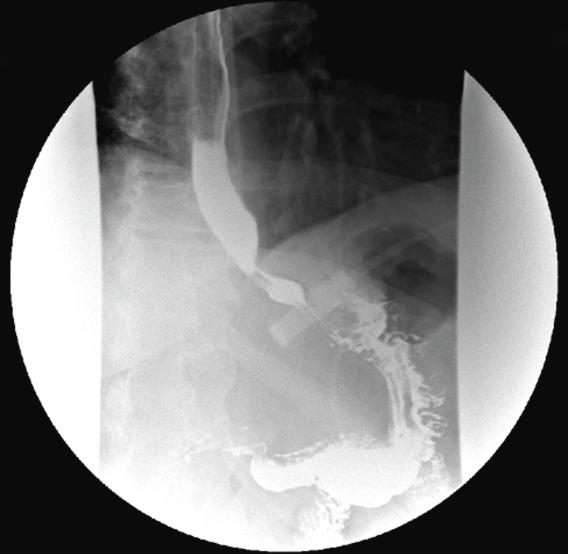
This is the most common bariatric operation now performed worldwide. The first step involves using the linear cutting stapler to separate a small proximal gastric pouch, again approximately 30 mL in volume, from the distal stomach, which is left in situ . The small bowel is then divided 50–100 cm beyond the duodenojejunal (DJ) flexure and the distal side anastomosed to the gastric pouch, in an antecolic or retrocolic position. The proximal side, representing the biliopancreatic limb of the Roux-en-Y reconstruction, is anastomosed 100–150 cm distal to the gastrojejunostomy ( Fig. 21.2 ). Any mesenteric defects are closed to prevent subsequent internal herniation.
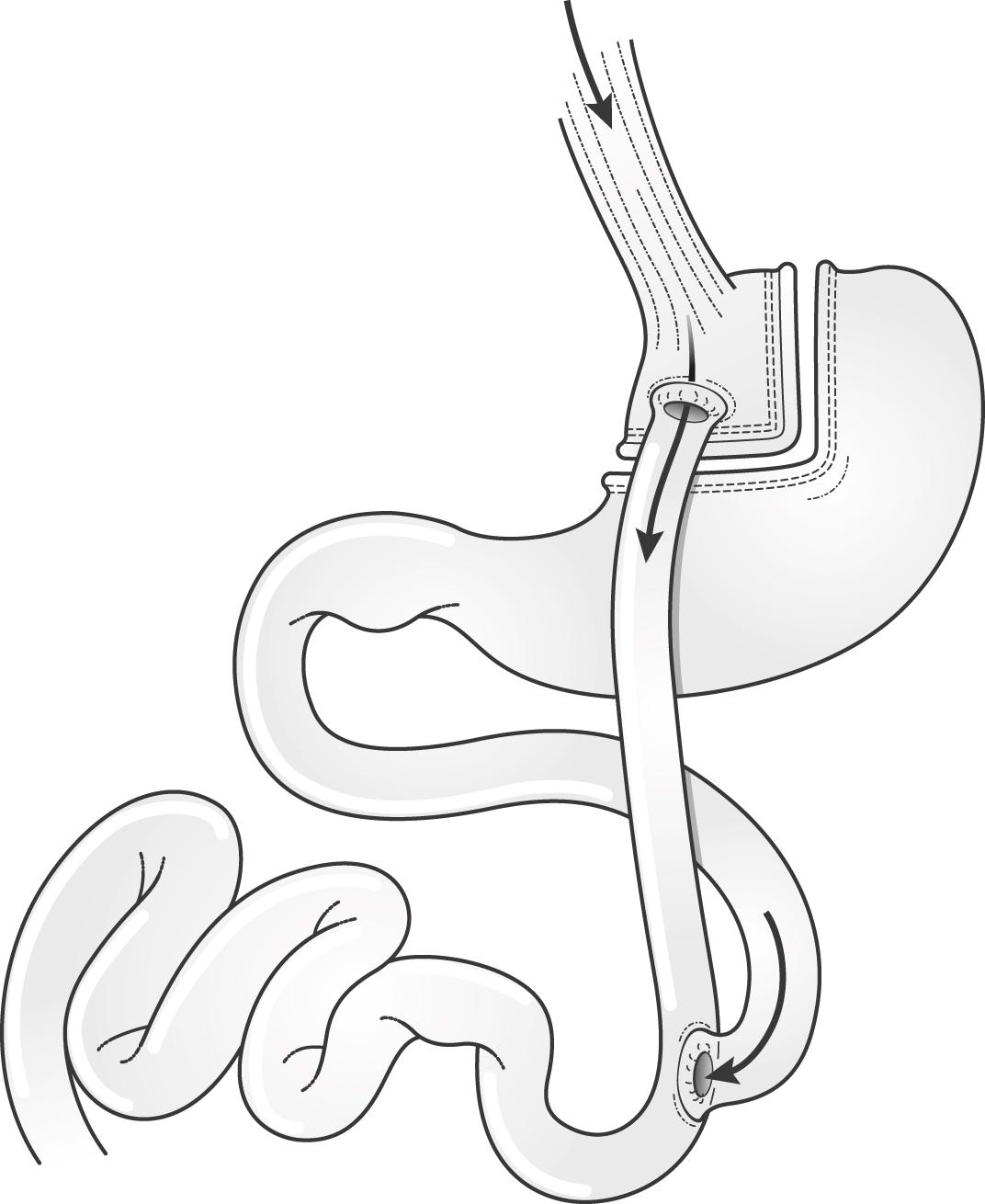
A more recent modification of the gastric bypass is the mini-gastric bypass, so called because it is quicker and easier to perform. The essential differences between this and a conventional bypass are that a longer gastric pouch is created and a Polya-type antecolic loop gastrojejunostomy, rather than a Roux-en-Y configuration, is constructed ( Fig. 21.3 ). Early results are satisfactory and longer-term outcome data are encouraging.
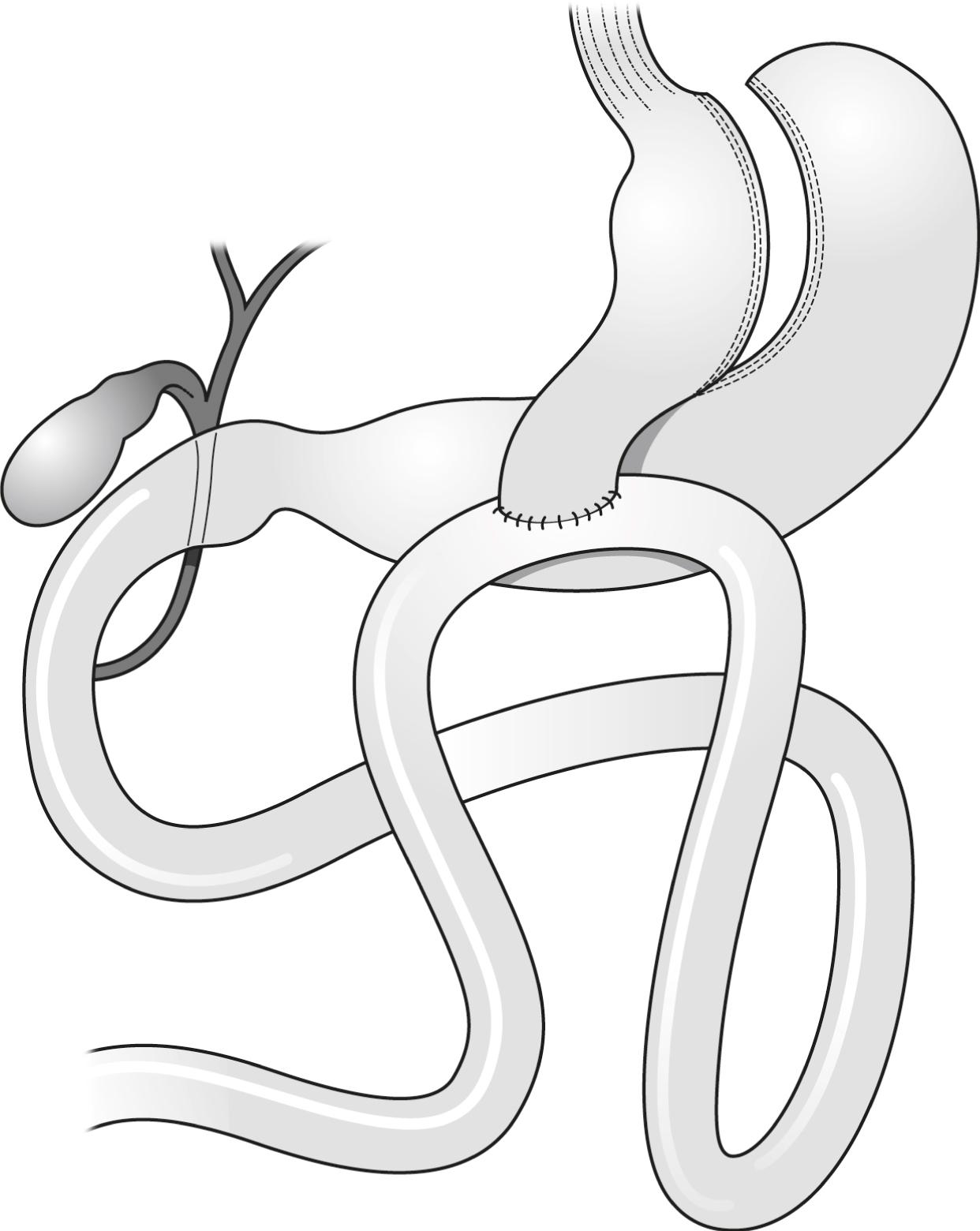
This operation was originally developed as the first stage of a duodenal switch operation but soon became a stand-alone procedure when its weight loss outcomes were, at least initially, similar to what was achievable with a gastric bypass. It is also technically easier to perform than any of the Roux-en-Y procedures, particularly in super-obese patients. The greater curve of the stomach is separated from the omentum from the angle of His to a point 5–6 cm proximal to the pylorus. A bougie, commonly around 34 French in size, is inserted down to the antrum and manipulated up against the lesser curve. Using a linear cutting stapler and with the bougie as a guide, the body and fundus of the stomach are excised and removed to produce a narrow, tubular stomach. Note that vagal innervation (and thus pyloric function) is preserved. ( Fig. 21.4 ).
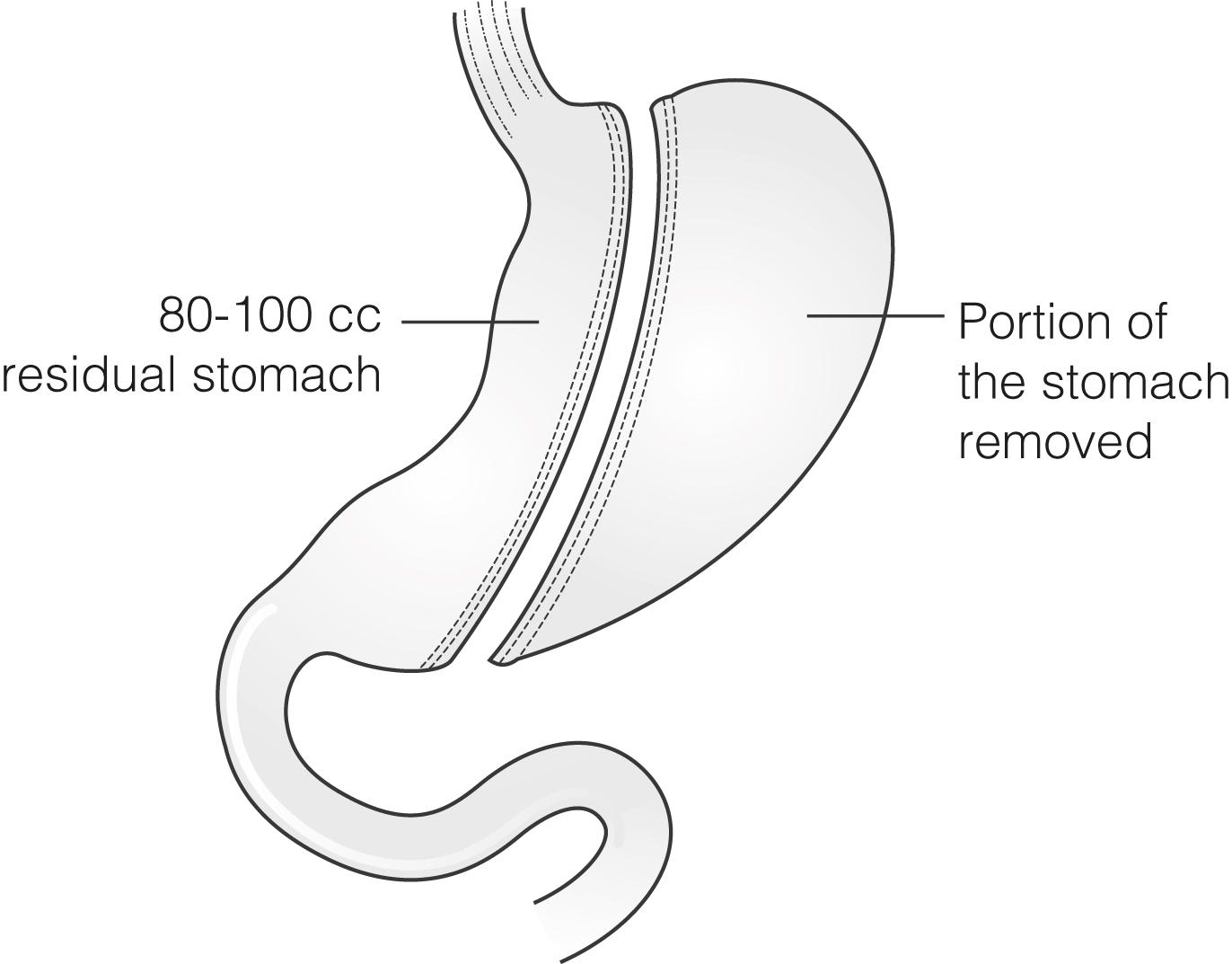
The duodenal switch, or biliopancreatic diversion (BPD) operation, can be performed as a two-stage procedure but is more commonly carried out in one sitting. The first stage is a conventional sleeve gastrectomy. The second stage involves dividing the duodenum just distal to the pylorus and then dividing the small bowel halfway between the DJ flexure and the ileocaecal junction. The distal part of the divided small bowel is then anastomosed to the proximal end of the divided duodenum just beyond the gastric outlet (pylorus). Thus the jejunum is ‘switched’ for the duodenum. The biliopancreatic (Roux) limb of the divided small bowel is then joined to the ileum 100 cm proximal to the ileocaecal valve. This creates a longer bypassed segment and a much shorter common channel than a standard gastric bypass procedure, resulting in significantly more malabsorption.
This plastic balloon is inserted endoscopically and inflated with saline under vision to between 500 and 700 mL ( Fig. 21.5 ). This induces a feeling of fullness and thus reduces oral intake. Because the satiety effect wanes after several months, combined with a small risk of leakage/deflation in situ , with the associated possibility of distal migration of the collapsed balloon, it is recommended that the balloon is removed after 6 months. Removal involves another endoscopic procedure in which the balloon is punctured, aspirated and withdrawn.
![]() There is little evidence to indicate which operation suits which patient, although most series demonstrate greater average weight loss from operations with a ‘malabsorptive’ component over ‘restrictive’ operations alone.
There is little evidence to indicate which operation suits which patient, although most series demonstrate greater average weight loss from operations with a ‘malabsorptive’ component over ‘restrictive’ operations alone.
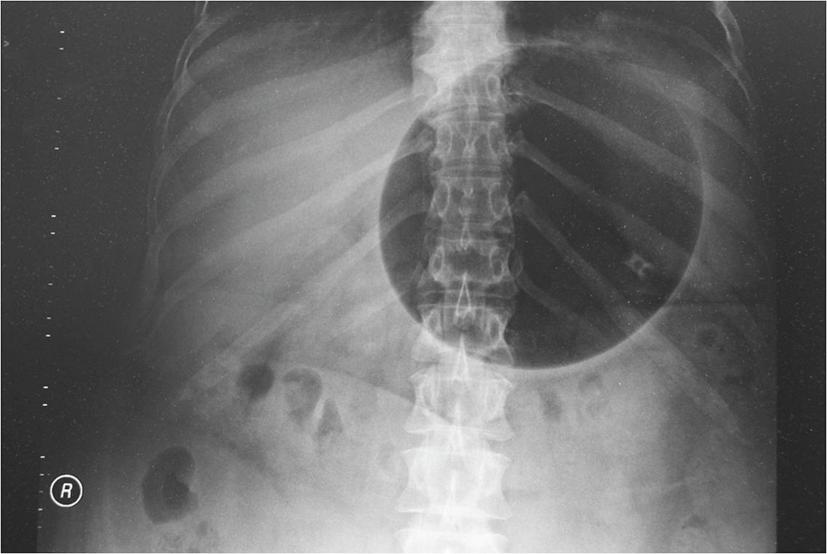
It is rare to see patients with an intact jejuno-ileal bypass today. This operation involved anastomosing the proximal jejunum to the terminal ileum less than 100 cm from the ileocaecal valve. It gained popularity between the 1950s and1970s before the emergence of the Roux-en-Y gastric bypass operation. The jejuno-ileal bypass resulted in significant protein malabsorption and vitamin/mineral deficiency, with the long blind jejunal limb commonly leading to bacterial overgrowth. Patients were prone to liver failure as a result of both protein malnutrition and toxaemia from bacterial overgrowth in the blind loop. The majority of patients, if still alive, have had their operations reversed.
The vertical banded gastroplasty (VBG) operation gained popularity in the 1980s and early 1990s, but its high failure rate and the advent of better procedures have resulted in it being abandoned. Just above the incisura, a short distance in from the lesser curve, the anterior and posterior walls of the stomach were stapled together with a circular stapler. Through the resultant hole made by the stapler, a linear stapler could be applied vertically towards the angle of His. This staple line fixed the anterior and posterior gastric walls together but did not divide the stomach. The outlet of the small gastric pouch thus created was then ‘banded’ with a 360 degree ring of tape to prevent dilatation ( Fig. 21.6 ). The high failure rate resulted from pouch outlet stenosis and/or pouch dilatation (usually caused by overeating) which was often followed by disruption of the vertical staple line with the consequent loss of restriction to eating.
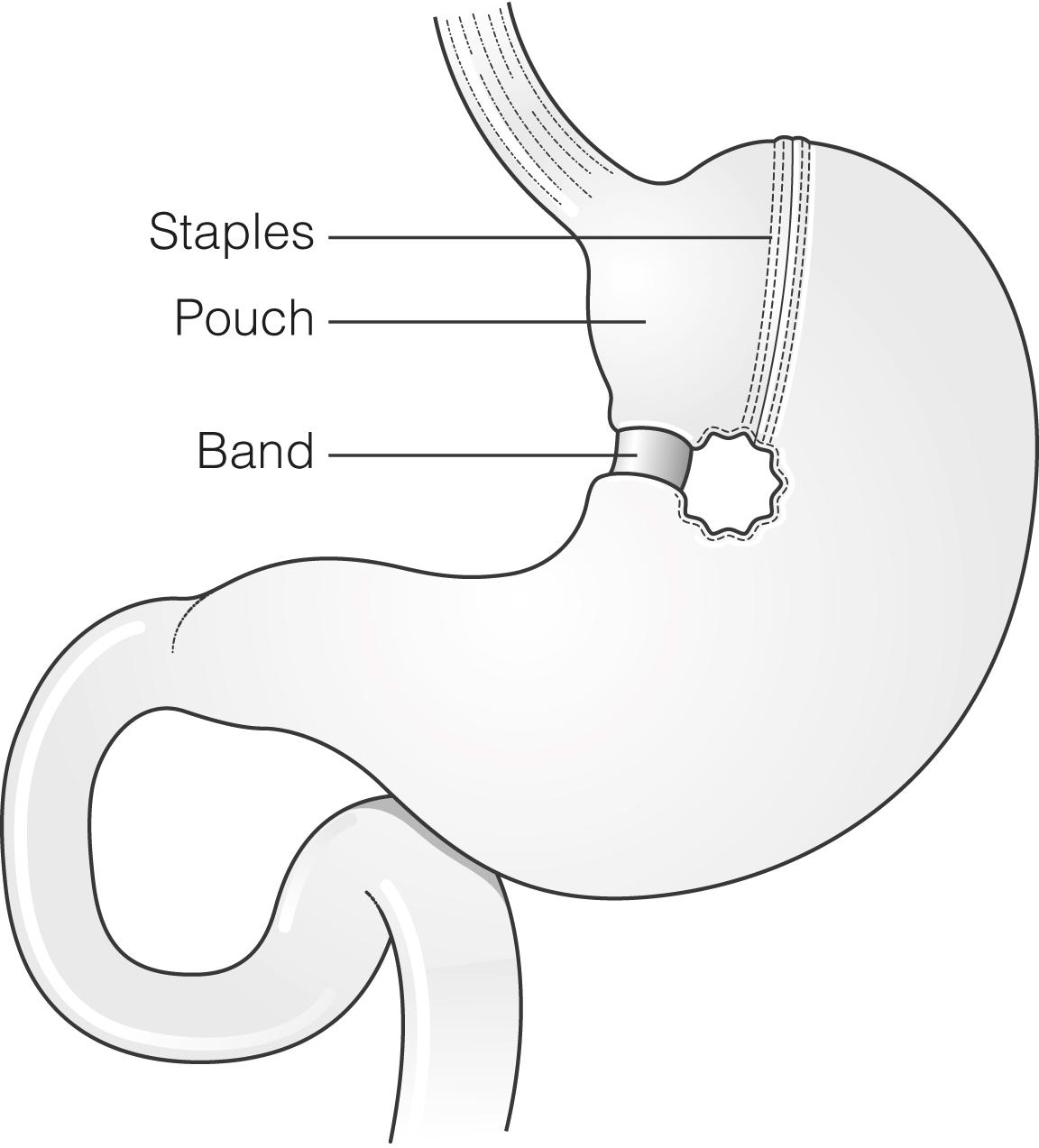
Reducing the size of the stomach either endoscopically or laparoscopically has been described where the greater curve of the stomach at the fundus is invaginated to reduce gastric volume. Infolding the gastric wall in this way may also provide stimulation of mural stretch receptors to reduce hunger. Endoscopically, this can be performed by firing a series of staples or clips that ‘gather’ the stomach wall from the inside. Outcomes are not yet known, but the same technology has been described previously for plicating the gastro-oesophageal junction for treating reflux where, despite early successes, long-term results have been disappointing.
A number of laparoscopically implantable devices are now undergoing trials. They register the presence of food in the stomach and are designed to mediate satiety by vagal feedback. Lack of outcome data in addition to concerns about battery life and cost are currently a block to their more widespread use.
This endoscopically inserted tube of thin, impervious plastic material has its proximal end secured to the mucosa of the first part of the duodenum with small barbs and then runs distally for 60 cm, effectively lining the duodenum and upper small bowel, preventing ingested food from making contact with the mucosa until the proximal jejunum is reached. Its effect on the gut hormone milieu mimics that of the gastric bypass and early clinical results have shown a similar improvement in type II diabetes control, along with modest weight loss. It is suggested that such barriers be removed at around 1 year. However, no long-term follow-up information is available regarding the extent of weight regain or the return of glucose intolerance after the barrier is removed and the technique has not gained popularity.
There are general complications such as might follow any abdominal operation, and specific complications that relate to the procedure performed.
It should be within the capability of any abdominal surgeon to manage the general complications of bariatric surgery, which include pulmonary atelectasis/pneumonia, intra-abdominal bleeding, anastomotic or staple-line leak with or without abscess formation, deep vein thrombosis (DVT)/pulmonary embolism (PE) and superficial wound infections. Patients may be expected to present with malaise, pallor, features of sepsis or obvious wound problems. However, clinical features may be difficult to recognise owing to body habitus. Abdominal distension, tenderness and guarding may be impossible to determine clinically due to the patient’s obesity. Pallor is non-specific and fever and leucocytosis may be absent. Wound collections may also be very deep. These complications in a bariatric patient should be actively sought with appropriate investigations. In particular, it is vital for life-threatening complications such as bleeding, sepsis and bowel obstruction to be recognised promptly and treated appropriately. A persistent tachycardia may be the only sign heralding significant complications and should always be taken seriously.
It is useful to classify complications as ‘early’, ‘medium’ and ‘late’ because, from the receiving clinician’s point of view, the differential diagnosis will differ accordingly ( Table 21.1 ). Early complications usually arise within the first few days of surgery but, with ever-advancing laparoscopic surgery and shorter lengths of stay, these may still present to the non-bariatric surgeon after the patient has left the specialist centre.
| Early | Medium or late |
|---|---|
| Bleeding: Intraluminal (staple/suture line) Intraperitoneal (staple/suture line, mesentery, omentum, liver/spleen injury) Subcutaneous (trocar site) |
Chest infection DVT/PE Haematoma or abscess Incisional or port-site hernia |
| Staple/suture line leak | |
| Inadvertent GI tract perforation | |
| Port-site haematoma/infection | |
| DVT/PE | |
| Anaesthetic drug reaction, etc. | |
| Chest infection/atelectasis | |
| Port-site hernia with or without bowel obstruction |
These relate to the procedure performed. Again, they may be grouped into ‘early’, ‘medium’ and ‘late’, although the ‘early’ complications overlap with the general complications mentioned above. Medium-term complications are likely to arise while the patient is still overweight and thus may be difficult to diagnose. Late complications may develop many years later. Patients at this stage may be of normal weight, and therefore a link to their previous bariatric surgery may not be obvious ( Table 21.2 ).
| Procedure | Early | Medium | Late |
|---|---|---|---|
| Band | Gastric perforation Liver/spleen injury with bleeding |
Slippage (with or without gastric necrosis) Injection-port migration or infection |
Slippage Erosion Injection-port problems Mega-oesophagus |
| Sleeve | Reflux oesophagitis Staple-line bleed or leak Splenic infarct Omental necrosis |
Intra-abdominal abscess or haematoma | Fistula Stenosis of sleeve |
| Bypass/duodenal switch/BPD | Anastomosis/staple-line bleed or leak Small-bowel enterotomy Early SBO |
Intra-abdominal abscess or haematoma Roux limb obstruction Biliopancreatic (blind) loop obstruction |
SBO (internal hernia, volvulus, adhesions) Anastomotic ulcer Anastomotic stricture Dumping syndrome Micronutrient malnutrition Gastro-gastric fistula Hypoglycaemia |
| Mini-gastric bypass | As above | As above | As above plus bile reflux |
| Intragastric balloon | Nausea/vomiting Gastric ulceration Gastric or oesophageal perforation |
Dehydration and electrolyte imbalance Reflux oesophagitis |
Bowel obstruction from deflated balloon |
| VBG | Stomal stenosis | Staple-line disruption | |
| JIB | Bowel obstruction (internal hernia, adhesions) | Malnutrition Blind loop syndrome Liver failure |
|
| Duodenal barrier | Duodenal bleeding Duodenal perforation |
Dumping syndrome Food bolus obstruction Migration of the device with mechanical bowel obstruction |
Unknown |
| Gastric plication | Bleeding Splenic or liver injury |
– | – |
| Gastric pacing | Nausea/vomiting Infection of subcutaneous implant |
– | – |
Once the receiving clinician understands the operation that has been performed and the specific complications to look out for, the next step is the interpretation of the presenting clinical features and formulation of a management plan.
Become a Clinical Tree membership for Full access and enjoy Unlimited articles
If you are a member. Log in here